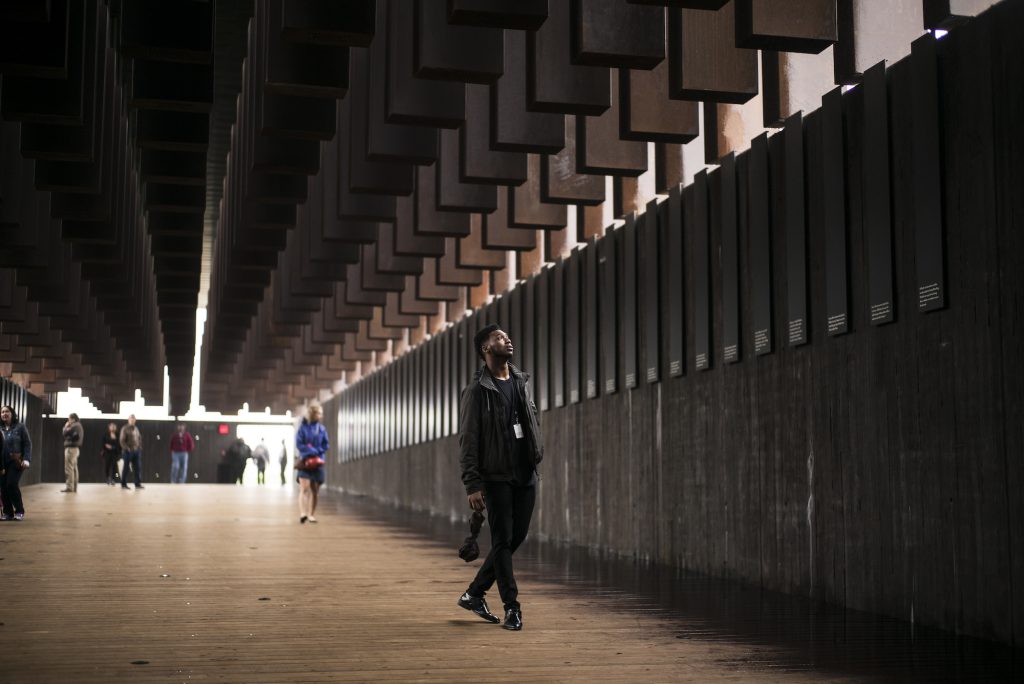The National Lynching Memorial Speaks to My Black ’Bama Body OR Imma Be Here Forever, You Gon’ Remember This

There was a pulsing I felt, a pulsing I still feel, a steady thrum in my chest that I am still not entirely sure what to make of—that surged when I stepped through the entrance of Alabama’s national lynching memorial. I looked up at a gate that was neither overtly welcoming nor softly shunning, but screaming. It was screaming silently of the ground in which the memorial was planted, as if a tree, and the memory that soil housed. It was screaming memories about the charred impressions from where a tree’s initial seed might have been planted and where exactly, years later, the bodies—hung taut above the earth—might have fallen. It was screaming about how the past does not forget, though we might, even though we might want it to.
The screaming was/is the pulsing; the pulsing was/is the history; the history was/is a Black one, carved into my historical biology of thick necks and broad shoulders, the indelible archive of a history made only accessible through birth. A story only now being told. A story of African American Blackness mired in guilt and grief and rage but that has deemed itself deserving of something beautiful. Of a homecoming. Of a reckoning.
My poem serves as an artistic exploration of the National Memorial for Peace and Justice, which is dedicated to Black people who were killed by racial terror lynchings in the U.S. (The spirit of my poem and some phrases come from my master’s thesis “How We Remember, How We Forget, and How We Remember to Forget: Traumas of Black Memory and Memorialization at the National Lynching Memorial.”) Between 1877 and 1950, white supremacists lynched more than 4,400 people. Located in the city of Montgomery, the memorial honors the lives of slaves, those terrorized by lynching, all who suffered under racial segregation and Jim Crow, and people of color who today bear ongoing consequences of that oppressive history.
This site and the research behind the memorial were incredibly important to me, not only because of my identities as a Black person and a Southerner but also because Alabama is my home state. Though I hail from Birmingham, a city cast in its own very specific racial and Civil Rights circumstances, the legacy of Montgomery—of being the southern pinnacle of both the slave trade and the Civil Rights Movement—is one that has wrapped itself inextricably around every facet of my own life, my own history, and my own almost invisible, almost intangible genealogy.
As I reference in the piece, I was not only looking for a history of the memorial, I came home to Alabama, to Montgomery, in an attempt to find the memory of my family. Or who they might be.
The National Lynching Memorial Speaks to My Black ’Bama Body
OR
Imma Be Here Forever, You Gon’ Remember This
“a hangin’ tree still a hangin’ tree even if ya’ replaced the body on the rope with a tire swing”
Which is to say,
The tree still bears the memory
of the weight
on its branches
even if we forgot that pain and
made it play
This is a poem about the could have been
About the might be again
About the reinvocation of a body
(BLACK)
Hangin’ at every heavy-trunked tree
Every thick-branched tree
Every tire-swung tree Who gon’ be on the rope this time?—My body (BLACK)? Me?—Maybe.
Grandma said
the past don’t never forget though we might and you know I know it remembers its oppression
You know I know it the land remembers what it was like to receive the blood of our dead, and you know I know
it our dead, too, remember.
Sangin’ so softly
softly to us their truths in a song of feeling:
in 1803 the slavemaster snapped his whip, and somehow, someway centuries later, I understand what that fear
must feel like.
Montgomery feels open, like a field.
Maybe a cotton one?
The streets
wide enough for bodies
wide enough for bodies in chains
Wide enough for the slave auction block-turned-roundabout
Wide enough for the slave warehouse-turned-museum
Wide enough for that National Memorial that Peace and Justice that Lynching place
risin’ steadily out the hill beside me juttin’ out into sky all graceful-like-so-graceful-like gray and black steel
essenced in the midst of longevity whisperin’ on open ears,
This ain’t even new—I been here—always been here—you just wasn’t lookin at—
Me
the Black ’Bama Body walks into this space and immediately feels like weepin’ pillars lookin’ like erected stone
coffins, I cannot speak no mo’, I have no words no mo’ to say for myself save the repetition of the victims’
names I see etched into the middle of
Me
the Black ’Bama Body walks into this space and descends, the hangin’ pillars risin’ steadily above me lookin’ like
stone angels suspended frozen in the midst of flight I wonder I wonder I wonder, Can it even be an angel if it
ain’t got wings can it even be an angel if it ain’t got wings can it even be an angel if it ain’t got—
Me
all around me this place is warm, glowin’ stone, embers and rock, a womb, an empty sanctuary, a Black Holiness
church-house after a full service, a thickness in the air, a residue of prayer, a fullness in its empty, an empty in its full,
a place made to be left, a space made to leave a hope upon,
an altar
Look up
you’ll see ’em inscribed
Listen
you’ll hear ’em speakin’
Parks Banks, 1922, lynched in Mississippi for carrying a photograph of a white woman
Caleb Gadly, 1894, hanged in Kentucky for “walking behind the wife of his white employer”
James Neely, lynched when he complained when a white store owner refused to serve him
David Hunter, lynched when he left the farm where he worked without permission
Warren Powell, lynched and accused of “frightening” a white girl
Mary Turner, who after denouncing her husband’s lynching by a
rampaging white mob, was hanged upside down, burned,
and then sliced open so that her unborn child
fell to the ground.
On an Alabama summer day each name looks hot to the touch.
Each rusted pillar a burnin’ eye on a stove screamin’ to the young toddler,
“touch me, touch me and burn.”
Do it
Each burn a name to learn, each welt a lesson never to be forgotten, each scar a wound to heal
Sing ’em softly
Say ’em loudly
Now bow your head
This is prayer
Remember this is a church-house
Bow your head
Soften your stance
Feel it in your bones
The history of this land is a history of trauma.
Now now now that is not all that it is, but that is what it was born into into into into
There is an opening out to the field
A cascade of Black bodies,
Reborn in oxidized steel,
Paralyzed,
Frozen in loss:
some
hands up,
arms stretchin’ endlessly upward
toward some higher plane
others,
encircled outward on an auction block she,
reaches toward him baby in her arms reaches toward her he,
frozen in tentative defiance he collapsin’ under the weight they,
all shackled they all in chains they wrapped tight ’round necks and ankles they,
faces all contorted with suffering they bodies hard as iron everything all covered in
rust
they/we, terror, still, they/we, shutdown, still,
paralyzin’ in waves, steadily calcifyin’ our bones, makin’ us, makin’ us as hard
as stone resolute as steel and iron oxidizin’ us in the forms of our deepest desperation,
plantation histories made manifest made contemporary made bodies made in historic slavery-made fissures
made bodies made lynching made present potentiality made lynching era times two made psychosocial
outcomes made wounds that never heal made psychological traumas transmitted intergenerationally made
traumas that never resolve made helplessness made us made me like these bodies before me into something like
stone.
If the sun shined in the right position,
I imagine these figures might be cast in some ethereal glow,
some spectral luminescence seeping into ours from another realm.
Make no mistake.
It is our
History is not too good for this our
History is this:
The small grassy hill from where you can see the Montgomery skyline striated through the thicket of hanging
pillars.
Where you can see the river where slaves were sold.
Where you can see the State Capitol building that once housed the Confederacy.
Where you can feel the breeze of historical progress made off the backs of Black people.
Where I can feel it flowin’ over my neck.
Where I can feel thousands of phantom eyes on me, judgment facin’ me on all sides.
Where I feel neither judged nor claustrophobic.
Where I feel uncharacteristically safe, wrapped in a tentative embrace by ghosts who may very well know me as
kin.
Where I feel as if I am rooted in a dream of some memory of some distant family reunion.
Where my eyes are wide open, starin’ at hundreds of people I should feel some connection with.
Where I am meetin’ the warm gazes of great aunts accompanied by the cool reserve of second, third, and fourth
cousins.
Where everyone here is, somehow, family.
Where everyone here is, somehow, safe.
Where this safety is tentative at best.
Where the dream flickers in and out.
Where the generational memory fades each time I attempt to look too intently at a face, try to find my mother’s
dimple in a pair of almond eyes, my grandmother’s curl in the lines of a weathered brow.
Where the dream all but collapses when I try to find my gait in someone else’s body, when I try to find myself in
the set of some old man’s shoulders.
Where I feel that flickering here, standin’ on this mound starin’ through thousands of names tryin’ to find my
family.
Where there is a hopelessness mixed into the awe of this act, a deep desperation melding with the reverence.
Where there is trauma.
Where I attempt to hold tight to my intangible lineage.
Where I attempt to make sense of the disappearing bodies in my dreams.
Imagine this
Wakin’ up one day
and not bein’ able to trace whose hands you have
and that all you know about them is that they are Black
and yes they are beautiful
and somebody said they were dangerous
once just once
imagine wakin’ up with a noose around your neck.
Can you?
I can.
I know this dream.
I know this I know this like I know the arch of my own back like I know the curve of my own palm like I know
the heaviness of my own gait the shelter of my own shoulders
the supreme contradiction of being full-of-empty-of-lonely-of-never-alone
like I know I just know that here this once just once more than anything else I know Free.

































